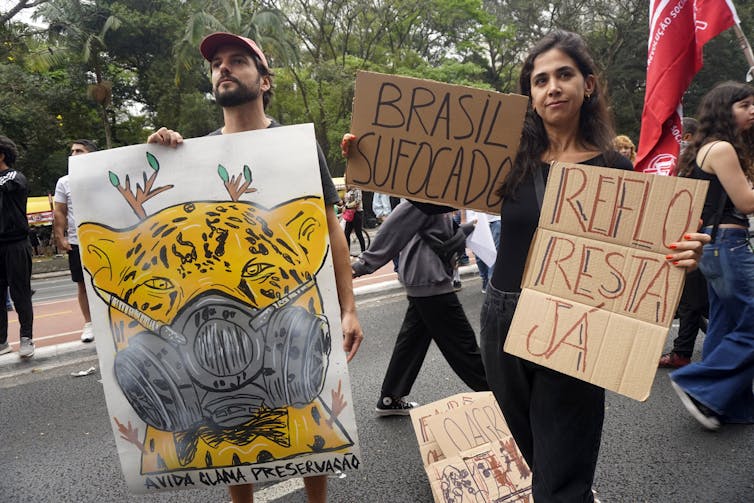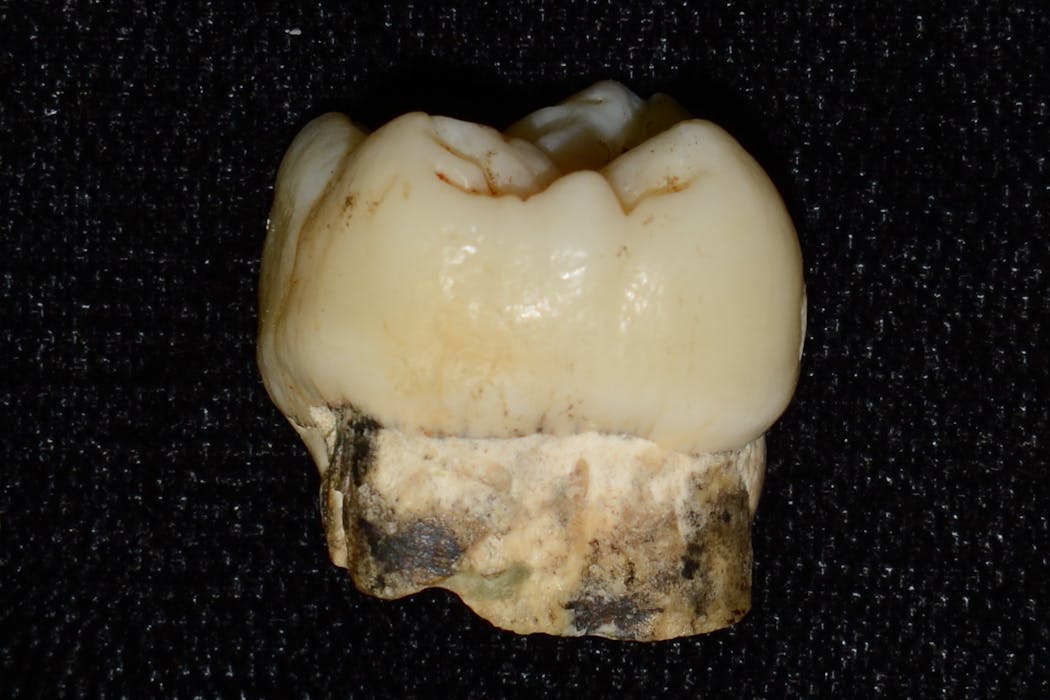Source: The Conversation – Global Perspectives – By Jan Lanicek, Associate Professor in Modern European History and Jewish History, UNSW Sydney
In November 2025, cinemas worldwide will release Nuremberg, a courtroom drama directed by James Vanderbilt. The film focuses on the International Military Tribunal against 24 major Nazi war criminals (though two were ultimately not tried) and seven Nazi organisations – including the SS, the Gestapo and the general staff of the army – at the end of the second world war.
Its release coincides with the 80th anniversary of the Nuremberg Trials, which officially opened on October 18 1945. The film explores our desire to see justice and reckoning for those who committed war crimes against civilian populations in the past and present.
The plot centres on the confrontation between Hermann Göring (played by Russell Crowe), a leading Nazi on trial, and psychiatrist Douglas M. Kelley (played by Rami Malek). Kelley’s task was to examine whether the top Nazis were fit to stand trial.
Nuremberg is often called “history’s greatest trial”. It was the first international trial that held senior governmental officials accountable for war crimes and crimes against humanity committed across Europe. It also established individual responsibility for committing war crimes, rejecting the defence of following the orders of superiors.
The indictment covered Nazi crimes before and during the war, against both soldiers and civilians. Nuremberg happened in a unique moment in time, when a country that triggered a major war was completely crushed by a military alliance willing to enforce its “unconditional surrender”.
It was also during the short time before the outbreak of the Cold War, when the wartime alliance between the East and West still held together. Such a trial seems unlikely to be repeated in our current historical moment.
What were the Nuremberg trials?
The International Military Tribunal, which held its hearings in Nuremberg, Germany, lasted for almost a year, until October 1946. It was the first in a series of 13 trials that brought to justice representatives of all the Nazi political, military and business elites, as well as mid-ranking representatives of the army, medical professionals and other Nazi agencies.
The reckoning was comprehensive, even though with the developing Cold War, the Western allies soon lost their appetite for further trials.
The Allies chose Nuremberg as the place for the trials for both political and practical reasons. Nuremberg was one of the centres of the Nazi movement. Numerous political rallies and parades took place there during Hitler’s rule. Also, the Palace of Justice in Nuremberg was one of the few suitable buildings that survived the near total destruction of Germany. It had the facilities needed for a major international tribunal.
Besides Göring, the defendants at the first trial included the Nazi foreign minister Joachim von Ribbentrop, military commanders Wilhelm Keitel and Alfred Jodl and armament minister Albert Speer. It also included the vicious antisemite Julius Streicher, and head of the Reich Security Main Office, Ernst Kaltenbrunner – the man in charge of the Nazi policies of persecution.
Several top representatives of Nazi Germany escaped justice: Adolf Hitler, Heinrich Himmler and Joseph Goebbels had died by suicide.
In popular memory, the Holocaust or Shoah, the mass extermination of the European Jews, is now commemorated as the main symbol of Nazi atrocities. But historians offer a mixed assessment of the role the Holocaust played during the Nuremberg trial.
While the persecution of the Jews did not dominate the proceedings, their fate was repeatedly emphasised as one of the Nazi crimes. Three Jewish survivors personally testified in the courtroom, reminding the world about the death of approximately six million Jews and incarceration of hundreds of thousands more who survived the ordeal of the camps.
In the courtroom, the prosecution played the footage from the liberated concentration camps, including Belsen and Buchenwald, which shook the audience – including the defendants. Defence witness Rudolf Höss, former commandant of Auschwitz, described the killing process in the gas chambers and crematoria in detail.
The Nazis’ persecution of other minorities received minimum coverage in the main trial. In addition to Jewish people, they also persecuted the Romani people, disabled people, homosexuals and religious minority groups.
Earlier efforts at international justice
Previous efforts to bring leaders of defeated states to justice and establish their accountability had been relatively unsuccessful. The Versailles Peace Treaty in 1919, for instance, promised to bring German leaders to justice for suspected war crimes during the first world war, though the effort never really materialised.
In the Soviet Union, trials of Nazi war criminals and local collaborators had already begun during the second world war. In 1943, the Krasnodar and Kharkov trials sentenced most defendants to death. In late 1944, a Soviet–Polish court sentenced guards from the Majdanek concentration camp to death. Further local trials continued in the first post-war months by the allied militaries, and new political authorities in the liberated countries.
But Nuremberg was the main piece in the puzzle of a comprehensive, often brutal retribution and cleansing all over Europe that brought tens of thousands of war criminals and collaborators to justice. Not only Germans, but also representatives of occupied nations accused of war crimes and collaboration, sat in the dock. Nazi war crimes trials, on a smaller scale, continued for decades.
In fact, just a few years ago, in 2022, 97-year-old Irmgard Furchner, a former secretary at a Nazi concentration camp, Stutthof, was found guilty of complicity in the murder of more than 10,500 people. She received a two-year suspended sentence.
‘History will judge us’
Nuremberg’s significance was political, legal, moral and historical. The tribunal prosecuting major war criminals “whose offenses have no particular geographical location” was jointly led by the four main Allied powers: the United States, the Soviet Union, Britain and France. Each had representatives among the judges and prosecution teams. The prosecutors also represented the interests of other, minor allies, such as Poland or Czechoslovakia, who could provide evidence for the trial.
The indictment listed four counts: conspiracy to commit crimes, crimes against peace, war crimes and crimes against humanity. In the first trial, 22 Nazis were in the dock.
In his opening speech, US Chief of Counsel for Nuremberg, Justice Robert H. Jackson, stressed:
the wrongs which we seek to condemn and punish have been so calculated, so malignant, and so devastating that civilization cannot tolerate their being ignored because it cannot survive their being repeated.
He continued, “We must never forget that the record on which we judge these defendants today is the record on which history will judge us tomorrow.”
The confirmation of the Nazi crimes that came with the liberation of Europe had shocked the world. When pushing the Wehrmacht (the armed forces of Germany’s Third Reich) from the east and west, seasoned Allied troops liberated destroyed villages and towns, coming across evidence of mass murder of civilians. In 1944 and 1945, the Red Army and western Allies liberated Nazi concentration camps, confirming the mass extermination of Jews and other groups.
At Nuremberg, the charge of “crimes against humanity”, in particular, punished crimes against civilians, such as “murder, extermination, enslavement, deportation, and other inhumane acts”. The promoter of this term was lawyer Hersch Lauterpacht, who was born in Galicia (then part of Austria-Hungary) and lived in the UK.
A competing legal terminology had been developed by another Galician-born lawyer, based in the US, Raphael Lemkin, who coined the term “genocide”. While the concept supported by Lauterpacht focused on the persecution of individuals, Lemkin stressed that the Nazi crimes were committed with the intent to destroy whole groups, particularly the Jews.
Although Nuremberg mentioned genocide on several occasions, the judges preferred “crimes against humanity” when characterising Nazi crimes. This legal concept allowed the Allies to punish German leaders for the persecution of their own citizens, even before the war.
As international lawyer and author Philippe Sands has said, this decision mean that “no longer would a state be free to treat its people entirely as it wished”.
A refined version of Lemkin’s term for genocide was officially enshrined in international law by the United Nations in 1948. It has been criticised for establishing a high threshold of proof. As a result, only a few cases of mass violence against civilians meet the criteria.
There were several notable moments during the trial. Göring, the former head of the Luftwaffe (German airforce), was considered the main defendant, and dominated the trial. Eventually, he had to be isolated from the other defendants, to allow them to speak more freely.
His questioning by Justice Jackson has been characterised as one of the worst cross-examinations in history. US attorney Robert Hedrick said, in 2016, that Göring was a “slippery” witness, who often complained about the translation of questions to buy time to think of an answer – and Jackson “did not control his witness”. But the prosecution had enough evidence to sentence him to death on all four counts, including crimes against humanity.
Rudolf Hess, deputy leader of the Nazi Party, escaped on a plane to Britain in 1941, allegedly with the aim to negotiate peace. He was imprisoned and kept in custody until the end of the war. In Nuremberg, Hess claimed amnesia and mental problems to avoid accountability for his crimes. In the end, he was sentenced to life in prison and died at Spandau prison in Berlin, in 1987.
Architect Albert Speer, who from 1942 became Hitler’s armament minister, cooperated with the court. He expressed remorse for the crimes he committed, though denied any knowledge of the Holocaust. These claims have later been disputed.
For instance, in 1971, Harvard University historian Erich Goldhagen found that Speer had attended a conference of senior Nazis in October 1943, at which SS head Himmler had spoken openly about “the extermination of the Jewish people”. (Though his biographer couldn’t confirm he had heard the speech in person, she concluded “he knew”.) He was sentenced to 20 years and was released in 1966, aged 61.
The judges sentenced 12 defendants to the death penalty. Martin Bormann, the head of the Nazi Party Chancellery and Secretary to Hitler, was sentenced in absentia. Although it was believed he was at large, it was later confirmed he died in the battle of Berlin in early May 1945.
Three defendants, Hitler’s minister of economics Hjalmar Schacht, propagandist Hans Fritzsche, and Hitler’s erstwhile conservative ally Franz von Papen were acquitted, despite the protest of the Soviet judge. Göring, sentenced to death, escaped justice by dying by suicide the night the execution was ordered.
International war crimes trials since Nuremberg
Nuremberg was the first major international trial for war crimes. It was followed by others. At around the same time, beginning in 1946, the International Military Tribunal for the Far East met in Tokyo, judging Japanese war criminals. The Tokyo Charter closely followed the Nuremberg Charter.
In the 1990s, in the post-Cold War period, the UN Security Council established two more ad hoc international criminal tribunals.
The International Criminal Tribunal for the former Yugoslavia was set up in the Hague, for war criminals from the wars in the former Yugoslavia. Its mandate lasted from 1993 to 2017. The International Criminal Tribunal for Rwanda convened in Arusha, Tanzania, to prosecute persons responsible for genocide and war crimes in the Rwandan civil war, committed in 1994. Both men and women were sentenced to long prison terms at these trials, including for the crime of genocide.
In 2002, the UN General Assembly approved the creation of the permanent International Criminal Court (ICC). Based on the Rome statute, the ICC can judge genocide, war crimes, crimes against humanity and the crime of aggression. However, some of the major world powers, such as the US, Russia, China and India, do not recognise its jurisdiction and do not cooperate with the court.
The ICC is currently investigating several states and their leaders, including Russia, Israel and a Hamas representative. Usually, only heads of smaller states, who lack strong international partners, sit in the dock. More powerful actors ignore the extradition requests, accusing the court of either pro-western bias, “neo-colonialist repression” or antisemitism.
Almost 80% of all indictments issued by the court have been against African leaders. The court has not opened one single case against leaders from the West.
Because of the indictment against Israeli leaders, the US has threatened the court with sanctions, and Hungary has withdrawn from the ICC. The ICC lacks the instruments to enforce extradition and can only rely on members’ cooperation. State leaders sought by the ICC travel relatively freely around the world, visiting major international states including permanent members of the UN Security Council.
Could the Nuremberg trials happen today?
A major trial of international significance – comparable to the Nuremberg Trials – would only be possible in the case of a major military defeat of the investigated government, and its occupation by those willing to bring the leading politicians to justice.
This is unlikely to happen. Countries are unwilling to extradite their leaders to international courts, unless they are coerced by circumstances. Many prefer to settle the scores on their home turf.
The Allies organised the Nuremberg trials with the hope of bringing the horrible chapter of Nazism to an end and sending a clear message for the future. The destruction, war crimes and crimes against humanity revealed at the end of the war truly shocked the world.
Even so, the East and West were only able to meet and sentence the German leaders during this brief historical moment before the outbreak of the Cold War.
With growing divisions in the world today, another Nuremberg is unlikely to happen any time soon.
![]()
Jan Lanicek receives funding from the Australian Research Council.
– ref. Friday essay: the Nuremberg Trials at 80 – could such a reckoning ever happen again? – https://theconversation.com/friday-essay-the-nuremberg-trials-at-80-could-such-a-reckoning-ever-happen-again-267313







